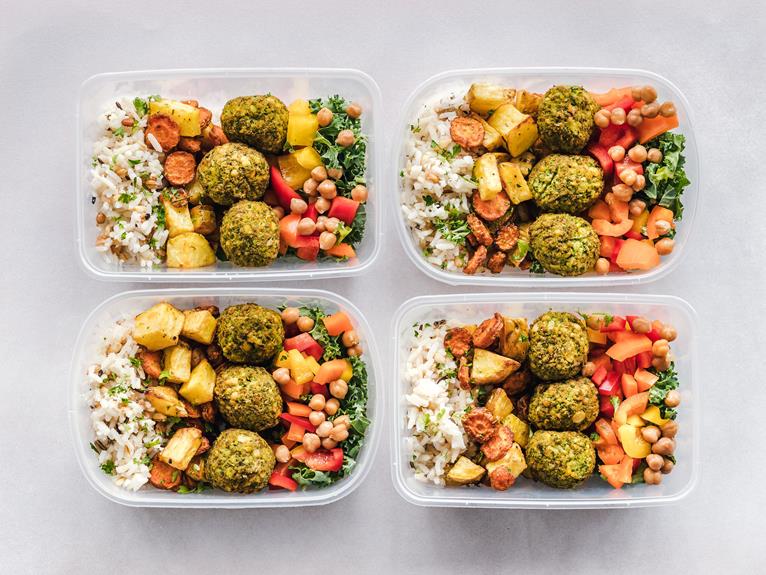For individuals new to the concept of meal planning, the idea of organizing and preparing meals in advance can be both exciting and intimidating. The thought of having delicious, nutritious meals ready to enjoy throughout the week is undoubtedly appealing, but the process of actually creating a meal plan can seem daunting.
Fortunately, with the right approach and tools, beginners can easily navigate the world of meal planning and experience its numerous benefits, including saving time, reducing stress, and maintaining a healthy diet.
In this article, we will delve into the fundamentals of meal planning for beginners and provide practical tips to help you get started on your journey to more organized and enjoyable eating habits.
Benefits of Meal Planning
Meal planning offers several benefits that can help simplify your cooking and eating routines. By incorporating meal planning into your life, you can save time, reduce stress, and make healthier choices.
One of the main advantages of meal planning is that it saves you time. Instead of aimlessly searching through the fridge each night, wondering what to cook, you can have a clear plan. This means less time spent wandering the grocery store aisles and more time enjoying the things you love.
Meal planning can help reduce stress. When you have a plan in place, you don’t have to worry about last-minute decisions or scrambling to find ingredients. You can approach each day with a sense of calm and confidence, knowing that your meals are taken care of.
Meal planning also leads to healthier choices. When you plan your meals, you have the opportunity to make intentional decisions about what you eat. You can ensure that your meals are balanced and include a variety of nutritious ingredients.
To start meal planning, set aside some time each week to plan your meals. Consider your schedule and choose recipes that fit your lifestyle. Make a shopping list based on the ingredients you need and stick to it when you go to the store.

How to Start Meal Planning
To start meal planning, take a proactive approach to organizing your meals in advance. Planning your meals ahead of time can help you save time, and money, and reduce stress. Here are some tips and strategies to get you started on your journey toward a more organized and efficient way of eating.
Set aside time each week to plan your meals. This could be on a Sunday afternoon or whenever works best for you. Consider your schedule, dietary preferences, and any special occasions or events coming up. This will help you create a well-balanced and personalized meal plan.
Next, make a list of the meals you want to prepare for the week. Include a variety of proteins, vegetables, grains, and fruits to ensure a nutritious and satisfying menu. Take stock of what you already have in your pantry and fridge and plan your meals around those ingredients to minimize waste.
Once you have your meal plan, create a shopping list. This will help you stay focused at the grocery store and avoid impulse purchases. Stick to your list and try to buy in bulk when possible to save money.
Lastly, prepare your meals in advance. This could involve prepping ingredients, cooking large batches, or even freezing meals for later. By having meals ready to go, you’ll be less tempted to order takeout or rely on unhealthy convenience foods.
Tools for Successful Meal Planning
Meal planning can be made easier and more efficient with the right tools. Here are some essential tools to enhance your meal-planning journey:
- Meal planning apps: Various meal planning apps are available to help you organize your meals, create grocery lists, and even suggest recipes based on your dietary preferences. These apps save you time and provide new ideas for delicious and healthy meals.
- Meal planning templates: Having a meal planning template helps you stay organized and ensures a well-balanced and varied diet. You can find printable templates online or create your own. These templates usually include space for planning breakfast, lunch, dinner, and snacks, making it easier to plan your meals for the week.
- Kitchen gadgets: Investing in handy kitchen gadgets can make meal prepping a breeze. From a slow cooker to a food processor, these tools save you time and effort in the kitchen.
- Digital kitchen scale: Using a digital kitchen scale helps you accurately measure ingredients and portion sizes. This is especially helpful if you’re following a specific diet or trying to manage your calorie intake.
- Storage containers: Having a good set of storage containers makes it easier to store and transport your prepped meals. Look for containers that are microwave-safe, dishwasher-safe, and stackable for easy storage.
Creating a Meal Planning Schedule
To effectively schedule your meal planning and ensure a well-balanced and organized approach to your weekly meals, follow these meal planning tips.
Start by setting aside dedicated time each week, such as a Sunday afternoon, to plan your meals. Brainstorm meal ideas and create a list of ingredients you’ll need.
Then, create a schedule for each day of the week, assigning specific meals to each day. Take into account your work schedule, family activities, and any special dietary requirements.
To save time, consider batch-cooking certain meals or ingredients, like grains or proteins, that can be used in multiple recipes throughout the week. Don’t forget to incorporate leftovers into the next day’s meal to minimize waste.
Budget-Friendly Meal Planning Tips
Save money while meal planning with these budget-friendly tips. Planning meals on a tight schedule can be challenging, especially for families with kids. But with a little creativity and smart shopping, you can create delicious and nutritious meals without breaking the bank. Here are some tips to help you get started:
- Buy in bulk: Purchasing staples like rice, pasta, and beans in bulk can save you money in the long run. Look for sales or consider joining a wholesale club to get the best deals.
- Use leftovers wisely: Instead of letting leftovers go to waste, repurpose them into new meals. For example, leftover roasted chicken can be used to make chicken salad sandwiches or added to a stir-fry.
- Plan around sales: Check your local grocery store flyers for weekly sales and plan your meals accordingly. This way, you can take advantage of discounted items and save money on your grocery bill.
- Cook in batches: Prepare large batches of meals and freeze them in individual portions. This not only saves time but also prevents food waste. Simply defrost and reheat when you’re ready to enjoy a home-cooked meal.
- Shop seasonally: Buying fruits and vegetables that are in season isn’t only more affordable but also tastier. Explore local farmers’ markets for the freshest produce at lower prices.
By following these tips, you can stretch your budget and still enjoy delicious meals for your family. Remember, meal planning doesn’t have to be complicated or expensive. With a little planning and creativity, you can create budget-friendly meals that are both nutritious and satisfying.
Meal Planning for Picky Eaters
If you have picky eaters in your household, meal planning can be a challenge. Dealing with picky eaters can involve finding recipes that everyone will enjoy, working with limited food options, and avoiding mealtime battles.
However, there are a few strategies that can make meal planning for picky eaters a little easier.
One effective strategy is to involve picky eaters in the meal planning process. Let them choose a meal or two each week and allow them to help with grocery shopping and meal preparation. This way, they feel a sense of ownership and are more likely to eat what they helped create.
Another strategy is to introduce new foods gradually. Start by adding small amounts of new ingredients to familiar dishes. For example, if your picky eater enjoys spaghetti, try adding some diced vegetables to the sauce. Over time, they may become more open to trying new foods.
It’s also important to offer a variety of options at mealtimes. Include at least one food item that your picky eater enjoys, along with a few new or less preferred options. This way, they’ve choices and can feel more in control of their meal.
Meal Planning for Busy Schedules
Planning meals can be a struggle when you have a busy schedule. But with a little bit of organization, it can become much easier. Here are some tips to help you get started:
- Plan: Take a few minutes each week to sit down and plan your meals for the upcoming days. This will save you time and stress during the week.
- Batch cooking: Prepare larger quantities of food and freeze individual portions. This way, you’ll always have a healthy meal ready to go, even on your busiest days.
- Use your slow cooker: Slow cookers are a great tool for busy people! Just throw in your ingredients in the morning, and by the time you come home, a delicious meal will be waiting for you.
- Make use of leftovers: Don’t let leftovers go to waste. Transform them into new meals by adding different ingredients or using them as fillings for sandwiches or wraps.
- Stick to a budget: Meal planning can help you save money. Plan your meals around affordable ingredients and take advantage of sales and discounts at your local grocery store.
With these tips, you can easily navigate the challenges of meal planning for families with busy schedules, all while sticking to a tight budget. Happy meal planning!
Healthy Meal Planning Ideas
If you’re looking to make your meal planning healthier, here are some ideas to consider.
One important tip is to focus on including more fruits and vegetables in your meals. You can add a variety of colorful vegetables to your salads, stir-fries, and soups. Don’t be afraid to experiment with different fruits for snacks or desserts.
Another idea is to incorporate lean proteins into your meal-planning recipes. Choose skinless chicken, turkey, or fish instead of red meat. Legumes such as lentils, chickpeas, and beans are also great sources of protein and can be used in a variety of dishes.
Don’t forget to include whole grains in your healthy meal planning. Swap refined grains like white rice and pasta for whole grains like quinoa, brown rice, and whole wheat pasta. These provide more fiber and nutrients.
Lastly, remember to include healthy fats in your meals. Avocados, nuts, and olive oil are great sources of healthy fats that are important for brain health and can help you feel satisfied.
Meal Planning for Weight Loss
Want to lose weight? Let’s talk about how meal planning can help you reach your weight loss goals. Meal planning is an effective strategy that can help you stay on track and make healthier choices. Here are some reasons why meal planning is beneficial for weight loss:
- Portion control: Planning your meals ahead of time allows you to control your portion sizes and avoid overeating.
- Nutritional balance: By planning your meals, you can ensure that you’re getting a well-balanced diet with all the necessary nutrients.
- Reduced temptation: When you have meals planned and ingredients on hand, you’re less likely to give in to unhealthy food cravings.
- Time-saving: Planning your meals saves you time during the week because you won’t have to worry about what to cook each day.
- Cost-effective: Meal planning can help you save money by reducing food waste and avoiding impulse buys at the grocery store.
Meal planning for weight loss can work for individuals or families on a tight budget. By taking the time to plan your meals, you can make healthier choices, control portion sizes, and save money.
Batch Cooking and Meal Prepping
If you want to save time and be more efficient during the week, try incorporating batch cooking and meal prepping into your meal planning routine. Batch cooking involves making large quantities of food at once, which can then be divided into portions and stored for future meals.
On the other hand, meal prepping means preparing ingredients or complete meals in advance, so they’re ready to be quickly assembled and cooked when needed. By dedicating a few hours on the weekend or a day off to batch cooking and meal prepping, you can significantly reduce the time spent on cooking during busy weekdays.
Here’s a helpful table to guide you in your batch-cooking and meal-prepping journey:
| Batch Cooking | Meal Prepping | Time Saving Meal Prep |
|---|---|---|
| Cook large batches | Prepare ingredients | Plan your meals |
| Portion and store | in advance | in advance |
| Freeze extras | Pre-cook proteins | Use make-ahead recipes |
| Use for future | for quick assembly | Utilize slow cooker |
| meals | or pressure cooker |
Batch cooking and meal prepping not only save time but also ensure that you have healthy and delicious meals readily available. It helps you avoid last-minute takeout or unhealthy food choices. So, start with batch cooking and meal prepping today and enjoy the benefits of a well-planned and time-saving meal preparation routine.
Tips for Grocery Shopping With a Meal Plan
To shop for groceries effectively, it’s important to align your choices with your meal plan and consider some helpful tips along the way. Here are some hacks and tips to make your shopping experience easier and more efficient:
- Create a detailed shopping list: Before going to the store, make a comprehensive list of all the ingredients you need for your meals. This will help you stay organized and avoid buying things on impulse.
- Stick to a schedule: Set a specific day and time each week for grocery shopping. By following a routine, you’ll be more likely to stick to your meal plan consistently.
- Focus on the perimeter of the store: The outer aisles of the grocery store usually have fresh produce, meats, and dairy products. Concentrate on these areas to find the majority of your ingredients, as they tend to be healthier and less processed.
- Take advantage of sales and discounts: Keep an eye out for weekly flyers and coupons to save money on your groceries. Planning your meals around sales can help you stay within your budget.
- Avoid shopping while hungry: Eating a small snack before going to the grocery store can help you avoid impulse purchases and unhealthy cravings.
Meal Planning for Special Dietary Needs
If you have special dietary needs, meal planning is even more important. Whether you have allergies or follow a vegan diet, planning your meals can help ensure you’re getting the right nutrients.
For those with allergies, meal planning is crucial to avoid triggers. Identify the foods you’re allergic to and make a list of safe alternatives. Plan your meals around these alternatives, making sure to include a variety of nutrients. Read food labels carefully and be aware of cross-contamination risks.
If you follow a vegan diet, meal planning can help you get all the necessary nutrients from plant-based sources. Include fruits, vegetables, whole grains, legumes, and plant-based proteins in your meal plan. Consider fortified foods or supplements for certain vitamins and minerals.
Troubleshooting Common Meal Planning Challenges
Struggling with meal planning? Don’t worry, you’re not alone! Meal planning can be challenging, but with a few troubleshooting tips, you’ll be back on track in no time. Here are some common challenges and how to overcome them:
- Lack of time: Finding time to plan and prepare meals can be difficult, but there are ways to save time. Try batch cooking on weekends, using slow cookers or pressure cookers, or even outsourcing some meal prep tasks to save time during the week.
- Lack of inspiration: It’s easy to get stuck in a meal-planning rut and feel uninspired. To overcome this, try exploring new recipes or cuisines, using meal planning apps or websites for ideas, or even asking friends and family for their favorite recipes.
- Limited budget: Eating healthy on a budget can be challenging, but it’s not impossible. Look for ingredient sales or discounts, buy in bulk, or plan meals around ingredients that are on sale. You can also consider incorporating budget-friendly ingredients like beans, lentils, or frozen fruits and vegetables.
- Picky eaters: Dealing with picky eaters can make meal planning frustrating. Try involving them in the process by letting them choose a meal or a few ingredients for the week. You can also try introducing new foods gradually and offering familiar options alongside new dishes.
- Lack of organization: Staying organized is key to successful meal planning. Consider using a meal planning template or app to keep track of your weekly menus, grocery lists, and recipes. Having a well-organized system will make meal planning much easier and less stressful.
Conclusion
When you start meal planning as a beginner, you can unlock a world of culinary delights that will tantalize your taste buds.
With the right tools and a touch of creativity, you can create a perfect balance between budget-friendly ingredients and dietary restrictions.
Let the art of meal planning guide you toward a symphony of mouthwatering and nourishing meals that will leave you feeling satisfied and accomplished.











